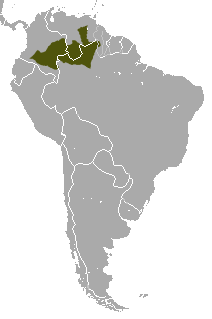Black titi
| Black titi[1] | |
|---|---|
 | |
| Scientific classification | |
| Kingdom: | Animalia |
| Phylum: | Chordata |
| Class: | Mammalia |
| Order: | Primates |
| Family: | Pitheciidae |
| Genus: | Callicebus |
| Subgenus: | Torquatus |
| Species: | C. lugens |
| Binomial name | |
| Callicebus lugens (Humboldt, 1811) | |
 | |
| Black Titi range | |
The black titi (Callicebus lugens) is a species of titi, a type of New World monkey, from South America. It is found in Brazil, Colombia, and Venezuela.
Communication
Some vocalizations of black titi are listed here: (1). Morning duet – the most commonly heard vocalization of the pair, singing in duet, complex and utilized to defend territory; it is interchanged with neighboring groups as counter-singing; (2) danger peep – various soft, high-pitched peeps but sometimes low intensity, advising of danger; very difficult to localize; (3) purr – sounds very much like a cat's purr; used by all members of the group to show contentment, affection or request for food, grooming or contact; (4) rough growl – given by young animals when complaining of rain or when greeting adults; (5) sharp scream – when fighting to express extra disgust; (6) play growl – low, gargling growl used in play and changing in tone, terminating in interrogative tone; (7) soft whine – especially young animals but also adults when requesting something of another such as food or while grooming another; (8) bark – loud, sharp and sudden bark when molested by the unwelcome close presence of other larger primates such as Lagothrix, Cebus, Ateles or raptors.[3]
References
| Wikispecies has information related to: Black Titi |
- ↑ Groves, C.P. (2005). Wilson, D.E.; Reeder, D.M., eds. Mammal Species of the World: A Taxonomic and Geographic Reference (3rd ed.). Baltimore: Johns Hopkins University Press. p. 143. OCLC 62265494. ISBN 0-801-88221-4.
- ↑ Veiga, L. M. & Palacios, E. (2008). "Callicebus lugens". IUCN Red List of Threatened Species. Version 2008. International Union for Conservation of Nature. Retrieved 3 January 2009.
- ↑ Defler, T. R. 2003. Primates de Colombia. Conservation International, Bogota.
